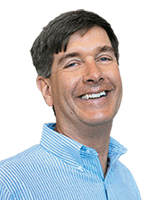The art of brushing
 Chip Howard, Ph.D., (turfsci@cox.net) owns the consulting business TurfScience, Inc., and manages several golf courses in the Southwest.
Chip Howard, Ph.D., (turfsci@cox.net) owns the consulting business TurfScience, Inc., and manages several golf courses in the Southwest.
Q: Brushing means something a little different to everyone. Describe brushing as you use it on the golf course.
A: The brushing equipment that I manufacture is not a “one brush accomplishes all.” The brushes are designed to provide appropriate and fruitful brushing options for every day of the year that greens are mowed. It is then the art of the superintendent to determine what degree of aggressiveness they desire to achieve the best results at any given time.
For example, on creeping bentgrass in the North, an extremely mild brush would be appropriate for the first mowings in spring or during mid-summer stress. However, an extremely aggressive brush would be appropriate for the May and September growth surges. In contrast, on bermudagrass, we use a mild brush in the winter, a medium brush through transition and switch to a very aggressive brush in mid-summer to counter the thatch accumulation.
Q: What are the major improvements to putting quality and putting green health you have seen by routine brushing?
A: Whether creeping bentgrass or bermudagrass, the concept is the same, although the things happen at different months of the year. What I have seen over the last 20 years of brushing is identical to virtually all the feedback I have received from superintendents. If brushing is begun during the growth seasons, after two weeks, the coarse-texture horizontal leaf blades will be gone and the remaining tissue will have a finer texture and be oriented vertically. After week three, the plants will have responded by making new plants in-between the existing plants. The result is increased density and finer texture. This greatly enhances the physics of ball roll.
Q: If greens are brushed daily, do you think mowing heights can be raised slightly without sacrificing green speed?
A: So many superintendents have reported this to me that it must be real. I certainly agree with whatever works for the individual who is responsible for the product. But I take a different approach. Once your leaf tissue is oriented vertically, it can tolerate unbelievably low mowing heights with no detectable ill effect. So, a consequence of brushing will be that a superintendent will have greater latitude for green speed. If they desire an extra foot of speed for a tournament, just lower the height 0.010 – 0.015 inches.
Q: What are the advantages of brushing over grooming or light verticutting?
A: As a superintendent, I gave up on grooming long ago, for many reasons. In order to get out of corners that I shouldn’t have gotten into, I found myself verticutting greens but holding my nose while doing so. The mechanical action of verticutting is damaging to the crown of the plants, and the after-effects seem to last a long time.
The extremely aggressive brushes are reported to be more effective at grooming than groomers but without the negative consequences. Though brushes can’t be as invasive as a piece of steel spinning at high speed as with verticutters, I am noticing that repeated use of aggressive brushes produces the same effect but without the negatives. That said, if your goal is to shred thatch for instant removal, verticutters get the job done that day.
Q: What brushing strategy do you recommend for season-long use and why?
A: My goal was to design a system by which a superintendent could brush every day they mow. As I mentioned, that can be done by having a spectrum of brush aggressiveness options available that can be matched to the agronomic needs of the day. To fulfill that need, I currently have six brush options available. I am also playing with some other brush devices that are clearly outside the box of current thinking, some of which may take us in new directions.
Clark Throssell, Ph.D., loves to talk turf. Contact him at clarkthrossell@bresnan.net.








